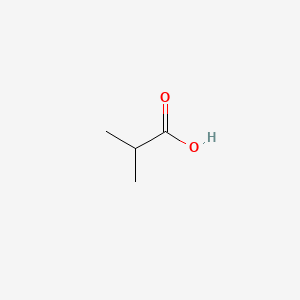| MeSH term | MeSH ID | Detail |
|---|---|---|
| Stomach Ulcer | D013276 | 75 associated lipids |
| Adenocarcinoma | D000230 | 166 associated lipids |
| Colonic Neoplasms | D003110 | 161 associated lipids |
| Body Weight | D001835 | 333 associated lipids |
| Carcinoma, Hepatocellular | D006528 | 140 associated lipids |
| Hyperlipidemias | D006949 | 73 associated lipids |
| Malabsorption Syndromes | D008286 | 16 associated lipids |
| Gastrointestinal Hemorrhage | D006471 | 27 associated lipids |
| Werner Syndrome | D014898 | 4 associated lipids |
| Myoclonic Epilepsies, Progressive | D020191 | 3 associated lipids |
ISOBUTYRIC ACID
ISOBUTYRIC ACID is a lipid of Fatty Acyls (FA) class. Isobutyric acid is associated with abnormalities such as Atrophy, Muscular, Spinobulbar. The involved functions are known as Signal Transduction, Oxidation, Vmax, Metabolic Inhibition and Regulation. Isobutyric acid often locates in Cytoplasm, Plasma membrane, peroxisome, Mouse Embryonic Fibroblast and Protoplasm. The associated genes with ISOBUTYRIC ACID are Candidate Disease Gene, CDKN1A gene, MYC gene, E2F1 gene and HBP1 gene. The related lipids are butyrate, Butyrates, lipid structure, Fatty Acids and Propionate. The related experimental models are Knock-out.
Cross Reference
Introduction
To understand associated biological information of ISOBUTYRIC ACID, we collected biological information of abnormalities, associated pathways, cellular/molecular locations, biological functions, related genes/proteins, lipids and common seen animal/experimental models with organized paragraphs from literatures.
What diseases are associated with ISOBUTYRIC ACID?
ISOBUTYRIC ACID is suspected in Atrophy, Muscular, Spinobulbar and other diseases in descending order of the highest number of associated sentences.
Related references are mostly published in these journals:
| Disease | Cross reference | Weighted score | Related literature |
|---|
Possible diseases from mapped MeSH terms on references
We collected disease MeSH terms mapped to the references associated with ISOBUTYRIC ACID
PubChem Associated disorders and diseases
What pathways are associated with ISOBUTYRIC ACID
There are no associated biomedical information in the current reference collection.
PubChem Biomolecular Interactions and Pathways
Link to PubChem Biomolecular Interactions and PathwaysWhat cellular locations are associated with ISOBUTYRIC ACID?
Visualization in cellular structure
Associated locations are in red color. Not associated locations are in black.
Related references are published most in these journals:
| Location | Cross reference | Weighted score | Related literatures |
|---|
What functions are associated with ISOBUTYRIC ACID?
Related references are published most in these journals:
| Function | Cross reference | Weighted score | Related literatures |
|---|
What lipids are associated with ISOBUTYRIC ACID?
Related references are published most in these journals:
| Lipid concept | Cross reference | Weighted score | Related literatures |
|---|
What genes are associated with ISOBUTYRIC ACID?
Related references are published most in these journals:
| Gene | Cross reference | Weighted score | Related literatures |
|---|
What common seen animal models are associated with ISOBUTYRIC ACID?
Knock-out
Knock-out are used in the study 'G1/S arrest induced by histone deacetylase inhibitor sodium butyrate in E1A + Ras-transformed cells is mediated through down-regulation of E2F activity and stabilization of beta-catenin.' (Abramova MV et al., 2006).
Related references are published most in these journals:
| Model | Cross reference | Weighted score | Related literatures |
|---|
NCBI Entrez Crosslinks
All references with ISOBUTYRIC ACID
Download all related citations| Authors | Title | Published | Journal | PubMed Link |
|---|---|---|---|---|
| Rossouw D et al. | Linking gene regulation and the exo-metabolome: a comparative transcriptomics approach to identify genes that impact on the production of volatile aroma compounds in yeast. | 2008 | BMC Genomics | pmid:18990252 |
| Rodrigues DF et al. | Architecture of thermal adaptation in an Exiguobacterium sibiricum strain isolated from 3 million year old permafrost: a genome and transcriptome approach. | 2008 | BMC Genomics | pmid:19019206 |
| Aklujkar M et al. | The genome sequence of Geobacter metallireducens: features of metabolism, physiology and regulation common and dissimilar to Geobacter sulfurreducens. | 2009 | BMC Microbiol. | pmid:19473543 |
| Rehman A et al. | Effects of probiotics and antibiotics on the intestinal homeostasis in a computer controlled model of the large intestine. | 2012 | BMC Microbiol. | pmid:22452835 |
| Wen ZT et al. | Biofilm formation and virulence expression by Streptococcus mutans are altered when grown in dual-species model. | 2010 | BMC Microbiol. | pmid:20398271 |
| Aidemark M et al. | Trichoderma viride cellulase induces resistance to the antibiotic pore-forming peptide alamethicin associated with changes in the plasma membrane lipid composition of tobacco BY-2 cells. | 2010 | BMC Plant Biol. | pmid:21156059 |
| Green SR et al. | Combination of sapacitabine and HDAC inhibitors stimulates cell death in AML and other tumour types. | 2010 | Br. J. Cancer | pmid:20924380 |
| Hansen CF et al. | A high dietary concentration of inulin is necessary to reduce the incidence of swine dysentery in pigs experimentally challenged with Brachyspira hyodysenteriae. | 2011 | Br. J. Nutr. | pmid:21736788 |
| Pluske JR et al. | Feeding different types of cooked white rice to piglets after weaning influences starch digestion, digesta and fermentation characteristics and the faecal shedding of beta-haemolytic Escherichia coli. | 2007 | Br. J. Nutr. | pmid:17298698 |
| Cross DE et al. | Herbs, thyme essential oil and condensed tannin extracts as dietary supplements for broilers, and their effects on performance, digestibility, volatile fatty acids and organoleptic properties. | 2011 | Br. Poult. Sci. | pmid:21491246 |
